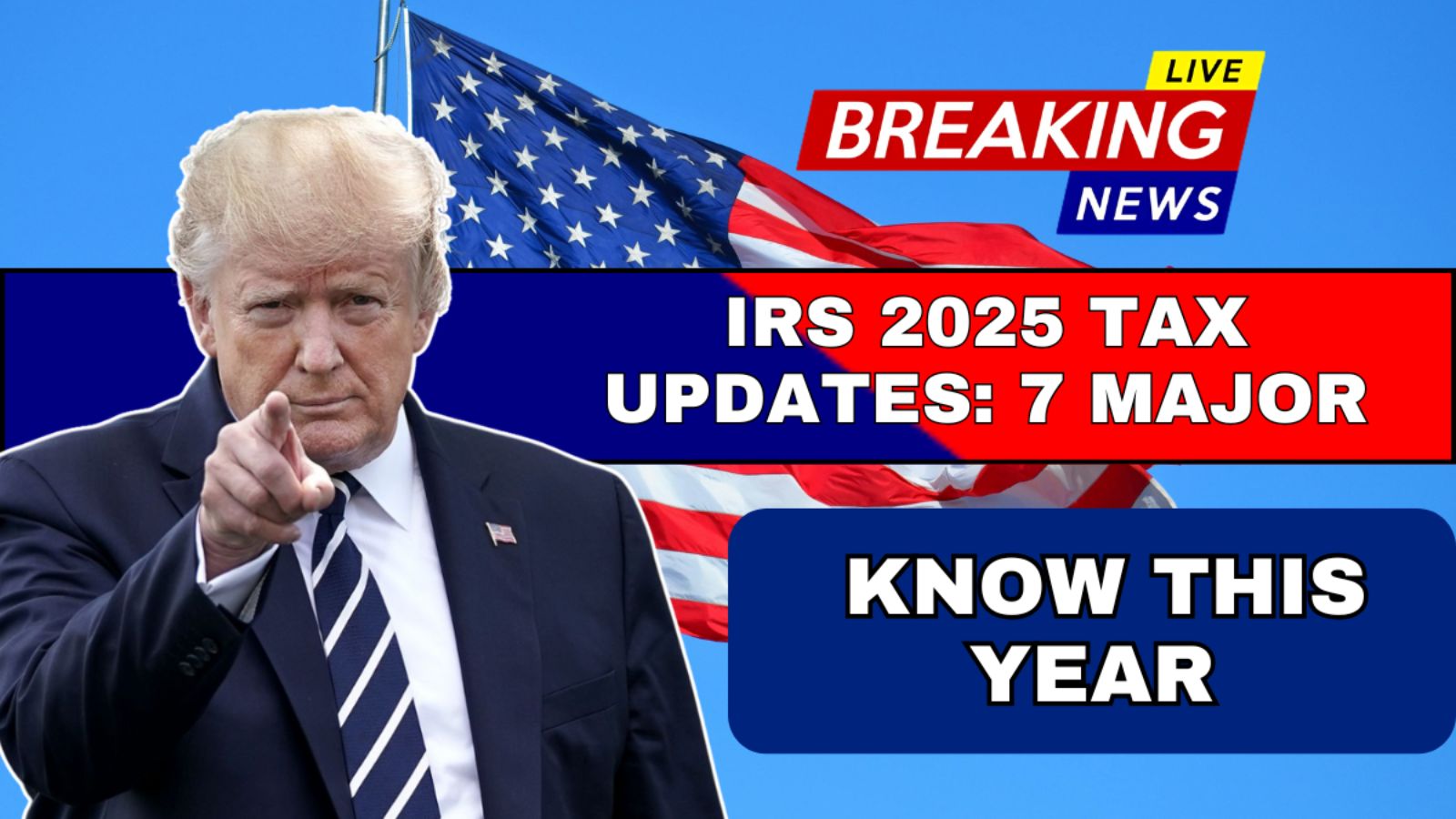Big news has arrived for millions of American taxpayers in 2025. The Internal Revenue Service (IRS) has officially announced a wave of tax reforms set to take effect from January 1, 2025, under what is now being referred to as the IRS 2025 Tax Updates initiative. These comprehensive changes are designed with a multi-faceted purpose: to counter inflation, provide additional support to working families, empower small businesses, and encourage environmentally responsible behavior.
If you live or work in the U.S. and pay taxes—whether you’re a salaried employee, a retiree, a small business owner, or self-employed—understanding these updates isn’t just helpful; it’s essential. Let’s take a detailed, section-by-section look at these IRS 2025 Tax Updates, and how each one could affect your financial decisions in the coming year.
IRS 2025 Tax Updates: Standard Deduction Increased to Offset Inflation
One of the most immediate and visible changes in the IRS 2025 Tax Updates revolves around the standard deduction—a figure that determines how much of your income is automatically tax-free. Every year, the IRS adjusts this amount in accordance with inflation. But this year, the jump is noticeably more substantial.
- For individual filers, the standard deduction will now range from approximately $13,000 to $15,000.
- For married couples filing jointly, the deduction will increase to nearly $28,179.
To better understand the real-world impact: Suppose an individual earns $45,000 annually. With a standard deduction of $15,000 under the new rule, they will only be taxed on $30,000 of income. That’s a meaningful reduction in taxable income—especially beneficial for low- and middle-income families.
With inflation continuing to affect everyday living expenses, this increase is intended to provide taxpayers with a little breathing room and keep more money in their pockets.
IRS 2025 Tax Updates: Inflation-Adjusted Tax Brackets to Prevent “Bracket Creep
Another major update under the IRS 2025 Tax Updates is the modification of federal income tax brackets. This might sound complex at first, but the goal is simple: to prevent bracket creep.
Bracket creep happens when inflation slightly boosts your income, pushing you into a higher tax bracket, even if your purchasing power hasn’t actually increased. To combat this, the IRS is now adjusting tax brackets in accordance with inflation, ensuring that taxpayers aren’t unfairly penalized for cost-of-living raises.
For example, the 22% tax bracket, which previously applied to incomes up to $95,000, may now apply to incomes up to $97,000 or more. This means many taxpayers will stay in the same tax bracket despite receiving modest pay raises, avoiding an unnecessary tax hike.
This is a welcome change for middle-income earners who frequently fall victim to bracket creep and end up paying more taxes even when their economic situation remains mostly the same.
IRS 2025 Tax Updates: Increased Contribution Limits for Retirement Accounts
Saving for retirement is a critical part of financial planning, and the IRS is encouraging Americans to do more of it. Under the IRS 2025 Tax Updates, contribution limits to popular retirement accounts are being raised significantly.
- The annual contribution cap for 401(k) plans is increasing from $23,000 to $24,500.
- Individuals aged 50 or older will continue to be eligible for catch-up contributions, potentially contributing even more.
- IRA (Individual Retirement Account) limits will also see modest increases.
What does this mean in practice? If you save $24,500 into a 401(k), that full amount is deducted from your taxable income. For many, this can translate to thousands of dollars in tax savings annually. It also means your retirement nest egg grows faster, thanks to both compound interest and reduced taxation.
This change incentivizes Americans to prepare for the future while enjoying immediate tax benefits—a double win.
IRS 2025 Tax Updates: Improved and Expanded Child Tax Credit
Families will be pleased to hear that one of the most beneficial credits—the Child Tax Credit (CTC)—is being expanded as part of the IRS 2025 Tax Updates. Until now, eligible families could claim up to $2,000 per child, but the IRS is proposing to increase that figure in 2025, potentially to $2,500 or more.
Additionally, the age eligibility is expected to expand. While the current credit typically applies to children under 17, new legislation may allow families to claim this credit for children who are 17 and possibly even 18 years old.
Take, for instance, a household with three children. Under the revised rules, that family could receive up to $7,500 in credits—money that directly reduces their tax bill. This boost will greatly assist with childcare, school supplies, extracurriculars, and daily household needs.
IRS 2025 Tax Updates: Green Incentives and Eco-Friendly Tax Relief
Going green isn’t just good for the planet anymore—it’s now great for your taxes too. As part of the IRS 2025 Tax Updates, a set of enhanced eco-friendly tax credits has been introduced to promote sustainability.
Eligible actions include:
- Installing solar panels on your home
- Purchasing an electric vehicle (EV)
- Making your home more energy efficient (e.g., new windows, insulation upgrades)
Let’s say you install solar panels worth $10,000. Under the IRS’s new green initiative, you could claim a tax credit of up to 50%, saving $5,000 off your tax bill. That’s not a deduction, but a credit—meaning it reduces your taxes dollar for dollar.
These incentives are designed to reduce energy consumption nationwide while rewarding individuals who make environmentally responsible decisions. And with energy prices continuing to rise, this is a financial and ecological win.
IRS 2025 Tax Updates: Key Changes for Small Businesses and Freelancers
Small businesses form the backbone of the American economy, and the IRS 2025 Tax Updates reflect an increased focus on supporting them. From new freelancers to established local businesses, several provisions will offer tax relief and simplicity.
Highlights include:
- Clearer guidance on digital income (online sales, freelancing, gig work)
- Expanded deductions for employee benefits
- Simpler processes for writing off equipment purchases
Imagine a small e-commerce store that spends $5,000 on new hardware and software. Under the updated IRS policies, a significant portion of that spend can now be deducted, potentially slashing the store’s taxable income.
These updates also aim to simplify compliance by clarifying how digital platforms should report transactions and how small businesses can claim operational costs. Entrepreneurs and side hustlers are strongly encouraged to consult with tax professionals to maximize these new opportunities.
IRS 2025 Tax Updates: Simplified Filing for Millions of Americans
One of the most transformative features of the IRS 2025 Tax Updates is the modernization of the tax filing process. Filing taxes has historically been a confusing, time-consuming ordeal—but that’s changing.
Key improvements include:
- Streamlined e-filing for individuals with single-income sources or pensions
- IRS-backed software that simplifies form entry and deduction searches
- AI-powered tools to catch mistakes and automatically suggest eligible credits
This will significantly benefit seniors, low-income earners, and individuals who aren’t tech-savvy. The goal is to make tax filing less intimidating and more accurate, saving people both time and money.
IRS 2025 Tax Updates: Summary Table
| Change | Impact |
|---|---|
| Standard Deduction Increase | Lowers taxable income; boosts refunds |
| Tax Bracket Adjustments | Prevents inflation from pushing earners into higher brackets |
| Retirement Contribution Boost | Encourages long-term savings with tax benefits |
| Expanded Child Tax Credit | Financial support for families with children |
| Green Tax Credits | Promotes sustainability and reduces taxes |
| Small Business Tax Reforms | Eases burden on entrepreneurs and digital workers |
| Simpler Tax Filing Process | Less hassle, especially for seniors and one-income families |
Conclusion: How to Prepare for the IRS 2025 Tax Updates
The IRS 2025 Tax Updates represent one of the most significant overhauls of the tax code in recent years. The changes aim to make the tax system more equitable, efficient, and responsive to the needs of everyday Americans. Whether you’re a full-time employee, a parent raising children, a small business owner, or someone planning for retirement, these updates offer meaningful opportunities to save money and optimize your tax strategy.
Now is the perfect time to speak with a financial advisor or tax preparer to ensure you’re positioned to take full advantage of every new provision. Early preparation, smart planning, and awareness of these updates can mean the difference between overpaying and saving thousands.
FAQs About IRS 2025 Tax Updates
Q1: What are the key highlights of the IRS 2025 Tax Updates?
A: The major highlights include increased standard deductions, adjusted tax brackets, enhanced child tax credits, new eco-friendly tax incentives, and simplified filing processes.
Q2: Has the IRS increased the standard deduction in 2025?
A: Yes, significantly. Single filers can deduct up to around $15,000, while joint filers can claim nearly $28,179.
Q3: How has the Child Tax Credit changed under IRS 2025 Tax Updates?
A: The credit has been increased to potentially $2,500 per child, and the age cap may be expanded to include older children.
Q4: What are the eco-friendly tax credits available in 2025?
A: Credits are available for solar panels, electric vehicles, and energy-efficient home upgrades—with up to 50% of eligible costs potentially refunded via tax credits.
Q5: Are there benefits for small businesses in the new updates?
A: Yes. There are clearer rules for digital income, expanded deductions for expenses, and easier processes for writing off equipment and employee benefits.
Some Important Link
| Telegram Group | Click Here |
| WhatsApp Group | Click Here |
| Home Page | Click Here |













